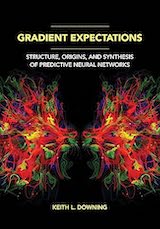
|
FreeComputerBooks.com
Links to Free Computer, Mathematics, Technical Books all over the World
|
|
- Title: Gradient Expectations: Structure, Origins, and Synthesis of Predictive Neural Networks
- Author(s) Keith L. Downing
- Publisher: The MIT Press (July 18, 2023); eBook (Creative Commons Licensed)
- License(s): Creative Commons License (CC)
- Hardcover/Paperback: 224 pages
- eBook: PDF and PDF Files
- Language: English
- ISBN-10: 0262545616
- ISBN-13: 978-0262545617
- Share This:

|
An insightful investigation into the mechanisms underlying the predictive functions of neural networks—and their ability to chart a new path for AI. It delves into the known neural architecture of the mammalian brain to illuminate the structure of predictive networks and determine more precisely how the ability to predict might have evolved from more primitive neural circuits.
About the Authors- Keith L. Downing is Professor of Artificial Intelligence and Artificial Life at the Norwegian University of Science and Technology and the author of Intelligence Emerging: Adaptivity and Search in Evolving Neural Systems (MIT Press).

- Gradient Expectations: Structure, Origins, and Synthesis of Predictive Neural Networks
- The Mirror Site (1) - PDF
-
 Understanding Deep Learning (Simon J.D. Prince)
Understanding Deep Learning (Simon J.D. Prince)
An authoritative, accessible, and up-to-date treatment of deep learning that strikes a pragmatic middle ground between theory and practice. Only the most important ideas to provide a high density of critical information in an intuitive and digestible form.
-
 Mathematical Introduction to Deep Learning (Arnulf Jentzen, et al)
Mathematical Introduction to Deep Learning (Arnulf Jentzen, et al)
This book aims to provide an introduction to the topic of deep learning algorithms, coverss essential components of deep learning algorithms in full mathematical detail including different Artificial Neural Network (ANN) architectures and algorithms.
-
 The Shallow and the Deep: Introduction to Neural Networks
The Shallow and the Deep: Introduction to Neural Networks
This book is a collection of lecture notes that offers an accessible introduction to Neural Networks and machine learning in general. The focus lies on classical machine learning techniques, with a bias towards classification and regression.
-
 Neural Networks and Deep Learning (Michael Nielsen)
Neural Networks and Deep Learning (Michael Nielsen)
Neural networks and deep learning currently provide the best solutions to many problems in image recognition, speech recognition, and natural language processing. This book will teach you the core concepts behind neural networks and deep learning.
-
 Machine Learning with Neural Networks (Bernhard Mehlig)
Machine Learning with Neural Networks (Bernhard Mehlig)
This modern and self-contained book offers a clear and accessible introduction to the important topic of machine learning with neural networks. It provides comprehensive coverage of neural networks, their evolution, their structure, their applications, etc.
-
 Neural Networks - A Systematic Introduction (Raul Rojas)
Neural Networks - A Systematic Introduction (Raul Rojas)
In this book, theoretical laws and models previously scattered in the literature are brought together into a general theory of artificial neural nets. It is aimed at readers who seek an overview of the field or who wish to deepen their knowledge.
-
 Deep Learning (Ian Goodfellow, et al)
Deep Learning (Ian Goodfellow, et al)
Written by three experts, this is the only comprehensive book on the subject. It offers mathematical and conceptual background, covering relevant concepts in linear algebra, probability theory and information theory, numerical computation, and machine learning.
-
 Deep Learning with Python, 2nd Edition (Francois Chollet)
Deep Learning with Python, 2nd Edition (Francois Chollet)
This book introduces the field of deep learning using Python and the powerful Keras library. It offers insights for both novice and experienced machine learning practitioners, and builds your understanding through intuitive explanations and practical examples.
-
 Dive into Deep Learning (Aston Zhang, et al.)
Dive into Deep Learning (Aston Zhang, et al.)
This is an open source, interactive book provided in a unique form factor that integrates text, mathematics and code, now supports the TensorFlow, PyTorch, and Apache MXNet programming frameworks, drafted entirely through Jupyter notebooks.
-
 Deep Learning for Coders with Fastai and PyTorch
Deep Learning for Coders with Fastai and PyTorch
This book show you how to train a model on a wide range of tasks using fastai and PyTorch. You'll also dive progressively further into deep learning theory to gain a complete understanding of the algorithms behind the scenes.





